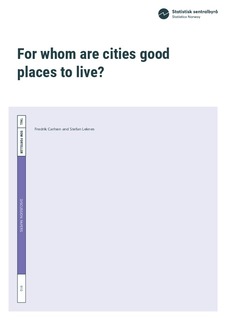For whom are cities good places to live?
| dc.contributor.author | Carlsen, Fredrik | |
| dc.contributor.author | Leknes, Stefan | |
| dc.coverage.spatial | Norge | nb_NO |
| dc.date.accessioned | 2019-07-22T12:01:26Z | |
| dc.date.available | 2019-07-22T12:01:26Z | |
| dc.date.issued | 2019-07 | |
| dc.identifier.issn | 1892-753X | |
| dc.identifier.uri | http://hdl.handle.net/11250/2606171 | |
| dc.description | This work was supported by the Research Council of Norway grant number 255509. | nb_NO |
| dc.description.abstract | We use survey data to examine whether there are some sociodemographic groups that particularly value the amenities that cities provide. We find that young, single and childless persons and young men with tertiary education are relatively more satisfied with urban areas as place of residence. Being single is more important for women's appraisal of places, while having children matters more for men’s preferences. There is a high degree of agreement between sociodemographic groups on whether a particular amenity represents an urban amenity or an urban disamenity. Higher education, public transportation, culture, leisure activities and shopping opportunities are urban amenities, whereas other public services, safety, living conditions for children and outdoor recreation are urban disamenities. | nb_NO |
| dc.language.iso | eng | nb_NO |
| dc.publisher | Statistisk sentralbyrå | nb_NO |
| dc.relation.ispartofseries | Discussion papers;910 | |
| dc.subject | Place satisfaction | nb_NO |
| dc.subject | Amenities | nb_NO |
| dc.subject | Population size | nb_NO |
| dc.subject | Sociodemographic groups | nb_NO |
| dc.subject | Befolkningsstørrelse | nb_NO |
| dc.subject | Sosiodemografier | nb_NO |
| dc.title | For whom are cities good places to live? | nb_NO |
| dc.type | Working paper | nb_NO |
| dc.description.version | publishedVersion | nb_NO |
| dc.source.pagenumber | 29 s. | nb_NO |
Tilhørende fil(er)
Denne innførselen finnes i følgende samling(er)
-
Discussion Papers [1002]
